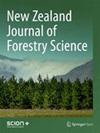Do leaf traits affect insect herbivory in a Chinese cork oak forest?
IF 1.5
4区 农林科学
Q2 FORESTRY
引用次数: 0
Abstract
Background: It is widely accepted that certain leaf traits indicating leaf quality play an important role in regulating insect herbivory. Numerous studies have attempted to find a clear relationship between insect herbivory and leaf traits. However, the results are inconsistent. In particular, it is still unclear whether leaf traits of a tree species affect insect herbivory in the field. Methods: We examined the effects of leaf traits including structural defensive traits (specific leaf area), nutritional traits (nitrogen content, water content, and soluble sugar content), and chemical defensive traits (tannin content and carbon content) on variation of insect herbivory among three forest strata (vertical variability) and 18 locations (horizontal variability) in a Chinese cork oak (Quercus variabilis) forest landscape. Results: Vertically, insect herbivory in the low-canopy stratum was significantly higher than in the other strata, but variation of leaf traits among strata had little explanatory power for the vertical pattern of insect herbivory. Horizontally, leaf carbon content had weak negative effects on insect herbivory while leaf tannin content had weak and divergent effects on insect herbivory in different strata. Conclusions: Leaf traits selected in this study have weak effects on insect herbivory in the Chinese cork oak forests we studied. These effects may be masked by other abiotic and biotic factors, but further examination is needed.叶片特征会影响中国栓皮栎林中昆虫的食草量吗?
背景:人们普遍认为,表明叶片质量的某些叶片性状在调节昆虫食草方面起着重要作用。许多研究都试图找到昆虫食草与叶片性状之间的明确关系。然而,研究结果并不一致。特别是,树种的叶片性状是否会影响昆虫在野外的食草性仍不清楚:方法:我们研究了中国栓皮栎(Quercus variabilis)森林景观中三个森林地层(垂直变异)和18个地点(水平变异)的叶片性状,包括结构防御性状(比叶面积)、营养性状(氮含量、含水量和可溶性糖含量)和化学防御性状(单宁含量和碳含量)对昆虫食草量变化的影响:结果:从垂直方向看,低冠层的昆虫食草量明显高于其他层,但层间叶片特征的变化对昆虫食草量的垂直模式几乎没有解释力。在水平方向上,叶片碳含量对昆虫草食性有微弱的负面影响,而叶片单宁含量对不同地层昆虫草食性的影响微弱且存在差异:本研究选择的叶片性状对所研究的中国栓皮栎林中昆虫的食草性有微弱的影响。这些影响可能被其他非生物和生物因素所掩盖,但还需要进一步研究。
本文章由计算机程序翻译,如有差异,请以英文原文为准。
求助全文
约1分钟内获得全文
求助全文
来源期刊

New Zealand Journal of Forestry Science
FORESTRY-
CiteScore
2.20
自引率
13.30%
发文量
20
审稿时长
39 weeks
期刊介绍:
The New Zealand Journal of Forestry Science is an international journal covering the breadth of forestry science. Planted forests are a particular focus but manuscripts on a wide range of forestry topics will also be considered. The journal''s scope covers forestry species, which are those capable of reaching at least five metres in height at maturity in the place they are located, but not grown or managed primarily for fruit or nut production.
文献相关原料
| 公司名称 | 产品信息 | 采购帮参考价格 |
|---|
 求助内容:
求助内容: 应助结果提醒方式:
应助结果提醒方式:


